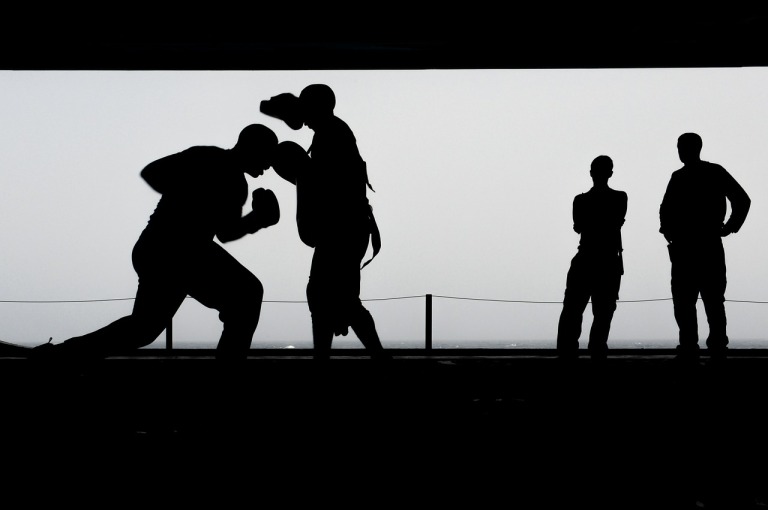
Room 111 in building 17 was transformed into a stage complete with foam mats, microphones, cameras connected to giant screens and about 3 dozen chairs lined up in rows. This room would serve as a stage for former Marine, stutman, theater director and master of fight choreography Chris White. White came prepared with a well organized powerpoint that was equipped with definitions, examples and videos. He started off by talking about the different kinds of fights. There are comedic fights (ex. Austin Powers), artistic fights (ex. Blood & Bone), Realistic (ex. Oldboy), and unrealistic (ex. Anchorman 2). White went on to discuss different actors across world who are known for participating in fight scenes. From the western parts of the world he talked about actors such as Douglas Fairbanks, John Wayne and Bruce Willis. From the eastern parts he talked about Akira Kurosawa, Bruce Lee and Ika Uwais (The Raid).
Once he managed to introduce us all to the basics of on-screen fighting, White walked us through how to create a successful fight scene. The first thing he stressed was how vital storyboards are. When writing a fight scene, the writer must establish a clear beginning, middle and end. He suggests keeping the scene high concept, in other words, the scene should be able to be explained in a sentence or two. This keeps the viewer from losing interest or getting confused.
The next important part to creating a successful fight scene is to establish the choreography- the movement of the talent, the movement of the lights and camera. In order to save time and money, White advises to always test your footage before getting on set. He told us to make sure to consider the costumes, the props and the CGI, because these all affect the choreography of the actors. The one word he mentioned more than any other was “rehearse”. He showed us a behind the scenes video of a fight scene where the female actress was smashed over the head by the weapon of her scene partner, because one of them moved just the slightest bit incorrectly. Speaking of weapons, White stressed how important it is to research your weapon before you include it in your film. He talked about the unfortunate accident with Brandon Lee on the set of The Crow and made it a point to stress the importance of gun safety on and off set.
Another aspect of successful fight scenes White talked about was camera movement. He spoke about the importance of how lighting works in a scene. If your scene is too dark, it usually implies that you don’t want your audience to see the poor stunts. The facial expressions of the characters are always important to consider. They affect the mood and the hierarchy levels of each character in the fight. White gave the example of having a character wince after being punched in the face and asked us what would happen if the character chose to smile instead. Those two facial expressions each convey very different feelings.
The last important pieces of advice for filming a successful fight scene were all about the editing, which Jackie Chan claims to be the most important part of the process. White taught the audience about the difference of cutting between action and cutting on action. He talked about how removing frames from a video makes the action seem quicker paced. One of my personal favorite things he said was about timing. White said that the audience doesn’t realize there’s a beat in a fight scene until it’s gone. It’s like a dance, and the whole crew must be dancing- the cinematographer, the talent, the editor, etc. He wrapped up the powerpoint by talking about sound and how no music can sometimes make for a more realistic looking sequence, but well-chosen music can add to the drama. Foley can really make or break a fight scene, because those hits must make impact and that illusion usually is created with sound.
After the powerpoint, White opened up the discussion to questions and gave students the opportunity to come up on stage and practice. The audience was able to see on the giant screen just how the action would look if it were being recorded. It was very interesting to see just how far a person’s fist can be from their partner’s face and still have the hit appear real on-screen. Throughout the workshop White continued to remind the audience that we have the potential to make great fight scenes and he quoted the incredible Jackie Chan who said “you can do it! Except, do you have the patience?” The most important lesson I took from this workshop was how necessary storyboards are. Before you start filming, your storyboard will establish your rules and create an all around smoother filming process. Overall, I really enjoyed the workshop and felt as if I took a decent amount of knowledge away from the experience. All I want to do now is film people getting beat up. Thank you to Chris White, LCC and the multimedia program for putting this together. I am looking forward to more workshops in the future.
Photo credits: skeeze, Pixabay – CC0 Public Domain
